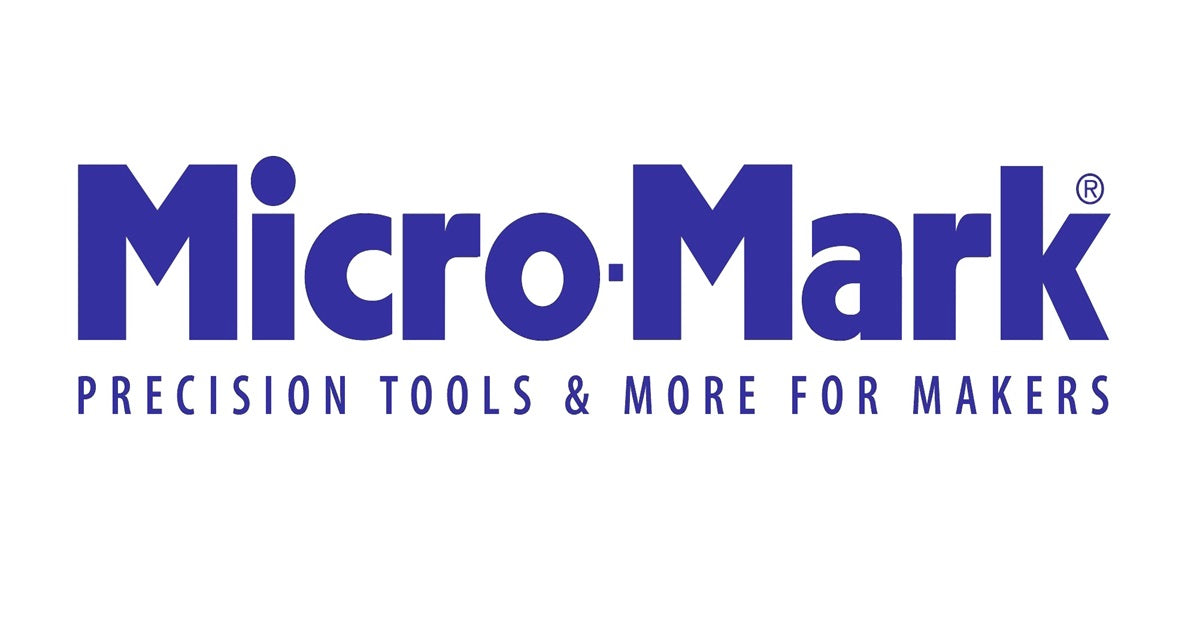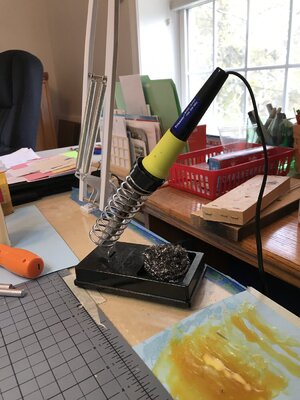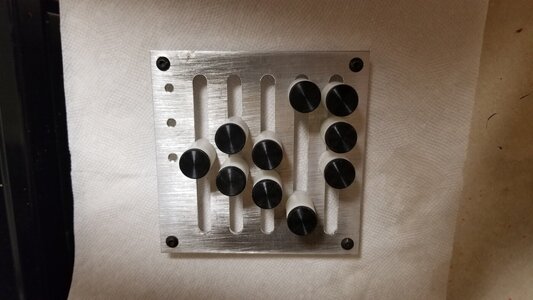This is how master Mikhail Bezverkhny does it:
-

Win a Free Custom Engraved Brass Coin!!!
As a way to introduce our brass coins to the community, we will raffle off a free coin during the month of August. Follow link ABOVE for instructions for entering.
- Home
- Forums
- Welcome to Ships of Scale Forum
- Beginners Corner - How to Get Started
- Basic Tools Needed
You are using an out of date browser. It may not display this or other websites correctly.
You should upgrade or use an alternative browser.
You should upgrade or use an alternative browser.
I would love to see a review on the fancy bending tool Stuart when it arrives.
.
.
The video proves that every plank is a project in itself. I think that if he added some water in his heat bending it would have gone easier with the steam being created from his soldering iron and also possibly in the toaster overall as a starter. Just thoughts. PT-2This is how master Mikhail Bezverkhny does it:
If I tried this (the first stage) my plank would be toast!This is how master Mikhail Bezverkhny does it:
You need a Russian toaster!If I tried this (the first stage) my plank would be toast!
- Joined
- Oct 9, 2020
- Messages
- 2,172
- Points
- 488

I like how he integrates the two bending directions into one step. I usually do it in two steps.This is how master Mikhail Bezverkhny does it:
Did you used electric plug adaptor or transformator to convert current or put 240 V on it ?My first attempt as a “novice“ builder was to cut out a template of the curve required for the planks, soak the planks overnight and then let them dry clamped to the cut out form. Since I really didn’t know what I was doing it worked for me.
View attachment 186780
Recently I graduated to this tool.
View attachment 186781
I had to adapt it to USA voltage and after a bit of a learning curve find it does quite the job. It’s sold by Kolderstok.
Jan
Michel
- Joined
- Oct 9, 2020
- Messages
- 2,172
- Points
- 488

me too. but it only allows you to bend the plank in one direction i think.I would love to see a review on the fancy bending tool Stuart when it arrives.
.
HI ALL, I GOT THE SAME THING FROM KOLDERSTOCK BUT JUST THE FITTINGS AND AS HEIRICH SAID ATWALL MART A SOLDERING IRON THAT WORKS WITH THE HEADS, WILL TRY IT FOR DRYING GLUE ON VENNER PLANKS, ON THE LEUDO' GOD BLESS STAY SAFE DON
I also have done compound bends in two axis generations and that seems to work OK with what I have had to do so far. . . nothing tight or radical, just longer sweeping bends. PT-2HI ALL, I GOT THE SAME THING FROM KOLDERSTOCK BUT JUST THE FITTINGS AND AS HEIRICH SAID ATWALL MART A SOLDERING IRON THAT WORKS WITH THE HEADS, WILL TRY IT FOR DRYING GLUE ON VENNER PLANKS, ON THE LEUDO' GOD BLESS STAY SAFE DON
I got a 30W soldering iron from Walmart and used the the parts from the Kolderstok iron. Even with an 240 volt adapter I don't think the the bender would get hot enough. PLANK BENDER, this post explains what I did.Did you used electric plug adaptor or transformator to convert current or put 240 V on it ?
Michel
Jan
Thanks you Jan. Someone knows if the tips could be used with Hakko standard ?
I soak my planks in water for half an hour, then put them in this plank bending jig to dry.
..View attachment 186475

Quality Tools & Supplies for Hobbys, DIY & Crafts – Micro-Mark Tools
We offer precision tools and supplies for all your hobby projects. Shop high-quality tools for model making, woodworking, painting, crafting and more!
 www.micromark.com
www.micromark.com
I'm not familiar with Hakko tools, but if the tips fit the same way as they do into the Walmart iron, (there are holding screws at the tip of the iron) it might work??Thanks you Jan. Someone knows if the tips could be used with Hakko standard ?
I don't have a clue as your electrical outlet voltage, mine is 120v AC 60 cycle.
Mine is currently configured to "iron" my planks, I find it very convenient and have it on my worktable. I found one thing to be a necessity, a good stable soldering iron holder.

Jan
Plank bending is definitely a conundrum for the hobby with many solutions! I have used two methods...well three really. First, depending on the thickness of the plank, I use CA gel and anchor one end...then work the plank around the curve using CA gel to anchor in place as I go. Works very well with thinner planks and gentle curves. Second I have used the electric plank bender as described above...soak the plank and work the curve using the hot tool and a form. Last, and actually how I work 80 percent of my curved planks, I use a mechanical plank bending tool. This is the plyer type tool with a blade on one jaw and a flat anvil for the other. It works by indenting the fat side of the plank causing the plank to curve. The closer the indents the sharper the curve. I just planked the Revenge 1577 using this tool (one version made by Amati).
- Joined
- Oct 15, 2017
- Messages
- 1,180
- Points
- 443

I too, like Brian use a similar tool. I've tried the soldering irons with the adapters and molds and soaking and clamping to the hull. I take a contour tool to get the shape of the hull then "eyeball" transfer it to this tool.Up to what thickness of plank will it bend?
I've found that this tool will handle any bending job I give it.
As far as how well it will do the job really depends on 3 things, thickness of the planking, wood type of the planking and finally the severity of the curve in the ship's bow. Softer woods are more malleable, harder woods less so. I've never had any trouble bending even 90 degrees over a 6-10 cm ever. I have had to soak harder woods longer in hot water, up to 60 minutes. BUT the aspect of this tool that I love is, depending on the width of your planking, you can bend up to 6 planks at once AND it is a passive tool!!! Unlike other planking tools that you have to actively work. Once you put your planks in this tool and wait for them to dry, you can get back to doing other things on your model. I'd rather put 6 planks in this thing and go work on something else for 2 hours than sit there for 2 hours bending planks
 Also, if you don't want to wait for them to air dry, you can hit them with a heat gun or hair dryer to speed things up. But I rather let them air dry and work on something else as we all know how monotonous planking can get.
Also, if you don't want to wait for them to air dry, you can hit them with a heat gun or hair dryer to speed things up. But I rather let them air dry and work on something else as we all know how monotonous planking can get.
Cheers,
Ken
Where would you find one?I too, like Brian use a similar tool. I've tried the soldering irons with the adapters and molds and soaking and clamping to the hull. I take a contour tool to get the shape of the hull then "eyeball" transfer it to this tool.
I've found that this tool will handle any bending job I give it.
As far as how well it will do the job really depends on 3 things, thickness of the planking, wood type of the planking and finally the severity of the curve in the ship's bow. Softer woods are more malleable, harder woods less so. I've never had any trouble bending even 90 degrees over a 6-10 cm ever. I have had to soak harder woods longer in hot water, up to 60 minutes. BUT the aspect of this tool that I love is, depending on the width of your planking, you can bend up to 6 planks at once AND it is a passive tool!!! Unlike other planking tools that you have to actively work. Once you put your planks in this tool and wait for them to dry, you can get back to doing other things on your model. I'd rather put 6 planks in this thing and go work on something else for 2 hours than sit there for 2 hours bending planks
Also, if you don't want to wait for them to air dry, you can hit them with a heat gun or hair dryer to speed things up. But I rather let them air dry and work on something else as we all know how monotonous planking can get.
View attachment 187424
Cheers,
Ken
I, too, have used all of the methods shown here, and they all work, with some variation depending on thickness, type of wood and bend radius. The one thing I have been doing differently lately is that I have substituted pure methanol for cold water. I learned about this from a furniture manufacturer. Soaking time is about the same as water, but methanol doesn't remain in the wood and cause swelling the way water does. Rapid and complete evaporation seems to be easier on the wood fiber, too. A soldering iron can still be used after the soak. Rubbing alcohol works fine too, but it does contain water.
- Joined
- Oct 15, 2017
- Messages
- 1,180
- Points
- 443

Hi Patrick,Where would you find one?
I found mine on eBay. It was used. But the similar tool that Brian and Smelly showed can be purchased from Micro Mark.

Quality Tools & Supplies for Hobbys, DIY & Crafts – Micro-Mark Tools
We offer precision tools and supplies for all your hobby projects. Shop high-quality tools for model making, woodworking, painting, crafting and more!
 www.micromark.com
www.micromark.com
Cheers,
Ken
- Joined
- Feb 15, 2019
- Messages
- 363
- Points
- 168

Hi Ian. No specific tools are necessary, and heat is not necessary, it's up to you. I would personally recommend making your own jig, soaking and setting. Again this is personal but I would avoid proprietary plank benders like the plague.Hi,
It won't be long until I'll be starting to plank my Santisima Trinidad and what I've noticed is that unlike my two previous builds the planking on this one is thick, so I was wondering what you guys would advise as to which bender would give the best results.
Cheers
IanG





